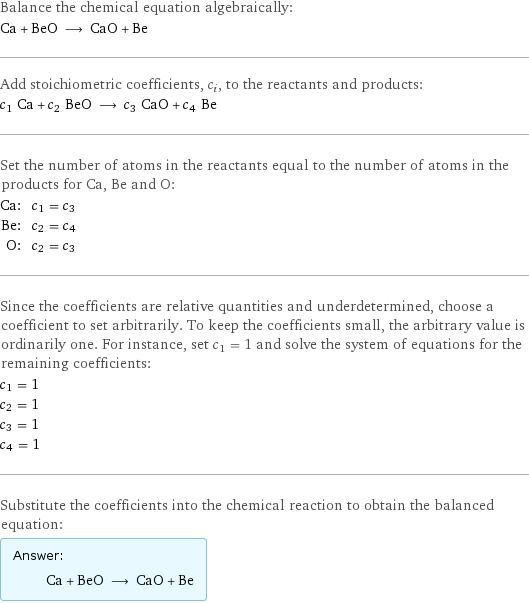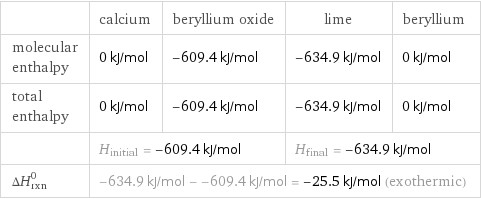Input interpretation

Ca calcium + BeO beryllium oxide ⟶ CaO lime + Be beryllium
Balanced equation

Balance the chemical equation algebraically: Ca + BeO ⟶ CaO + Be Add stoichiometric coefficients, c_i, to the reactants and products: c_1 Ca + c_2 BeO ⟶ c_3 CaO + c_4 Be Set the number of atoms in the reactants equal to the number of atoms in the products for Ca, Be and O: Ca: | c_1 = c_3 Be: | c_2 = c_4 O: | c_2 = c_3 Since the coefficients are relative quantities and underdetermined, choose a coefficient to set arbitrarily. To keep the coefficients small, the arbitrary value is ordinarily one. For instance, set c_1 = 1 and solve the system of equations for the remaining coefficients: c_1 = 1 c_2 = 1 c_3 = 1 c_4 = 1 Substitute the coefficients into the chemical reaction to obtain the balanced equation: Answer: | | Ca + BeO ⟶ CaO + Be
Structures

+ ⟶ +
Names

calcium + beryllium oxide ⟶ lime + beryllium
Reaction thermodynamics
Enthalpy

| calcium | beryllium oxide | lime | beryllium molecular enthalpy | 0 kJ/mol | -609.4 kJ/mol | -634.9 kJ/mol | 0 kJ/mol total enthalpy | 0 kJ/mol | -609.4 kJ/mol | -634.9 kJ/mol | 0 kJ/mol | H_initial = -609.4 kJ/mol | | H_final = -634.9 kJ/mol | ΔH_rxn^0 | -634.9 kJ/mol - -609.4 kJ/mol = -25.5 kJ/mol (exothermic) | | |
Entropy

| calcium | beryllium oxide | lime | beryllium molecular entropy | 41 J/(mol K) | 14 J/(mol K) | 40 J/(mol K) | 10 J/(mol K) total entropy | 41 J/(mol K) | 14 J/(mol K) | 40 J/(mol K) | 10 J/(mol K) | S_initial = 55 J/(mol K) | | S_final = 50 J/(mol K) | ΔS_rxn^0 | 50 J/(mol K) - 55 J/(mol K) = -5 J/(mol K) (exoentropic) | | |
Equilibrium constant
![Construct the equilibrium constant, K, expression for: Ca + BeO ⟶ CaO + Be Plan: • Balance the chemical equation. • Determine the stoichiometric numbers. • Assemble the activity expression for each chemical species. • Use the activity expressions to build the equilibrium constant expression. Write the balanced chemical equation: Ca + BeO ⟶ CaO + Be Assign stoichiometric numbers, ν_i, using the stoichiometric coefficients, c_i, from the balanced chemical equation in the following manner: ν_i = -c_i for reactants and ν_i = c_i for products: chemical species | c_i | ν_i Ca | 1 | -1 BeO | 1 | -1 CaO | 1 | 1 Be | 1 | 1 Assemble the activity expressions accounting for the state of matter and ν_i: chemical species | c_i | ν_i | activity expression Ca | 1 | -1 | ([Ca])^(-1) BeO | 1 | -1 | ([BeO])^(-1) CaO | 1 | 1 | [CaO] Be | 1 | 1 | [Be] The equilibrium constant symbol in the concentration basis is: K_c Mulitply the activity expressions to arrive at the K_c expression: Answer: | | K_c = ([Ca])^(-1) ([BeO])^(-1) [CaO] [Be] = ([CaO] [Be])/([Ca] [BeO])](../image_source/23cd91ff42aa69a4064aa1989a5eef1a.png)
Construct the equilibrium constant, K, expression for: Ca + BeO ⟶ CaO + Be Plan: • Balance the chemical equation. • Determine the stoichiometric numbers. • Assemble the activity expression for each chemical species. • Use the activity expressions to build the equilibrium constant expression. Write the balanced chemical equation: Ca + BeO ⟶ CaO + Be Assign stoichiometric numbers, ν_i, using the stoichiometric coefficients, c_i, from the balanced chemical equation in the following manner: ν_i = -c_i for reactants and ν_i = c_i for products: chemical species | c_i | ν_i Ca | 1 | -1 BeO | 1 | -1 CaO | 1 | 1 Be | 1 | 1 Assemble the activity expressions accounting for the state of matter and ν_i: chemical species | c_i | ν_i | activity expression Ca | 1 | -1 | ([Ca])^(-1) BeO | 1 | -1 | ([BeO])^(-1) CaO | 1 | 1 | [CaO] Be | 1 | 1 | [Be] The equilibrium constant symbol in the concentration basis is: K_c Mulitply the activity expressions to arrive at the K_c expression: Answer: | | K_c = ([Ca])^(-1) ([BeO])^(-1) [CaO] [Be] = ([CaO] [Be])/([Ca] [BeO])
Rate of reaction
![Construct the rate of reaction expression for: Ca + BeO ⟶ CaO + Be Plan: • Balance the chemical equation. • Determine the stoichiometric numbers. • Assemble the rate term for each chemical species. • Write the rate of reaction expression. Write the balanced chemical equation: Ca + BeO ⟶ CaO + Be Assign stoichiometric numbers, ν_i, using the stoichiometric coefficients, c_i, from the balanced chemical equation in the following manner: ν_i = -c_i for reactants and ν_i = c_i for products: chemical species | c_i | ν_i Ca | 1 | -1 BeO | 1 | -1 CaO | 1 | 1 Be | 1 | 1 The rate term for each chemical species, B_i, is 1/ν_i(Δ[B_i])/(Δt) where [B_i] is the amount concentration and t is time: chemical species | c_i | ν_i | rate term Ca | 1 | -1 | -(Δ[Ca])/(Δt) BeO | 1 | -1 | -(Δ[BeO])/(Δt) CaO | 1 | 1 | (Δ[CaO])/(Δt) Be | 1 | 1 | (Δ[Be])/(Δt) (for infinitesimal rate of change, replace Δ with d) Set the rate terms equal to each other to arrive at the rate expression: Answer: | | rate = -(Δ[Ca])/(Δt) = -(Δ[BeO])/(Δt) = (Δ[CaO])/(Δt) = (Δ[Be])/(Δt) (assuming constant volume and no accumulation of intermediates or side products)](../image_source/34e77673284f1b5b4a0b348f512505cb.png)
Construct the rate of reaction expression for: Ca + BeO ⟶ CaO + Be Plan: • Balance the chemical equation. • Determine the stoichiometric numbers. • Assemble the rate term for each chemical species. • Write the rate of reaction expression. Write the balanced chemical equation: Ca + BeO ⟶ CaO + Be Assign stoichiometric numbers, ν_i, using the stoichiometric coefficients, c_i, from the balanced chemical equation in the following manner: ν_i = -c_i for reactants and ν_i = c_i for products: chemical species | c_i | ν_i Ca | 1 | -1 BeO | 1 | -1 CaO | 1 | 1 Be | 1 | 1 The rate term for each chemical species, B_i, is 1/ν_i(Δ[B_i])/(Δt) where [B_i] is the amount concentration and t is time: chemical species | c_i | ν_i | rate term Ca | 1 | -1 | -(Δ[Ca])/(Δt) BeO | 1 | -1 | -(Δ[BeO])/(Δt) CaO | 1 | 1 | (Δ[CaO])/(Δt) Be | 1 | 1 | (Δ[Be])/(Δt) (for infinitesimal rate of change, replace Δ with d) Set the rate terms equal to each other to arrive at the rate expression: Answer: | | rate = -(Δ[Ca])/(Δt) = -(Δ[BeO])/(Δt) = (Δ[CaO])/(Δt) = (Δ[Be])/(Δt) (assuming constant volume and no accumulation of intermediates or side products)
Chemical names and formulas

| calcium | beryllium oxide | lime | beryllium formula | Ca | BeO | CaO | Be name | calcium | beryllium oxide | lime | beryllium IUPAC name | calcium | oxoberyllium | | beryllium
Substance properties

| calcium | beryllium oxide | lime | beryllium molar mass | 40.078 g/mol | 25.011 g/mol | 56.077 g/mol | 9.0121831 g/mol phase | solid (at STP) | solid (at STP) | solid (at STP) | solid (at STP) melting point | 850 °C | 2410 °C | 2580 °C | 1278 °C boiling point | 1484 °C | 4300 °C | 2850 °C | 2970 °C density | 1.54 g/cm^3 | 3.01 g/cm^3 | 3.3 g/cm^3 | 1.85 g/cm^3 solubility in water | decomposes | insoluble | reacts | insoluble
Units
